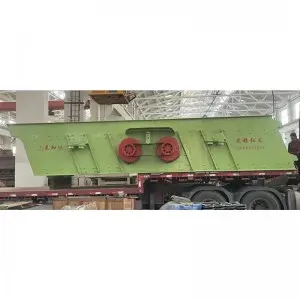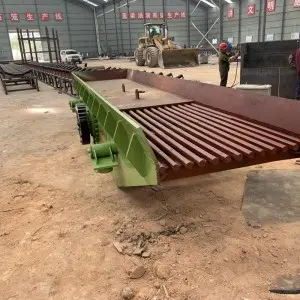In the crushing operation scenario, the ZW series vibrating feeder, as a key link in material transportation, its operational stability is directly related to the cleanliness of the surrounding environment. The sealing design, as the core guarantee for equipment to deal with dust problems, not only affects the service life of the equipment itself, but also relates to the safety of the working environment and the health of the operators. A thorough understanding of the sealing design logic and the actual dust protection effect of the ZW series vibrating feeder is of great significance for ensuring the efficient operation of the crushing production line.
First, the core design concept of the seal for the ZW series vibrating feeder
When the vibrating feeder is in operation, the material conveying process is accompanied by continuous vibration, which brings special challenges to the sealing design – it is necessary to ensure the tightness of the sealing structure while adapting to the vibration characteristics of the equipment to avoid wear or fracture of the sealing parts due to rigid connections. The sealing design of the ZW series vibrating feeder is carried out around the concept of “adapting to vibration and multi-layer protection”, forming a systematic design from key connection parts to the overall protection structure.
The connection and sealing between the feed inlet and the material silo is the primary line of defense. The feed inlet, as the first checkpoint for materials to enter, is also the main area where dust is prone to overflow. The ZW series vibrating feeder adopts flexible sealing parts here. The material has certain elasticity and wear resistance, which can closely fit the connection surface between the feeding port and the material bin. At the same time, it undergoes slight deformation with the vibration of the equipment, avoiding the formation of gaps due to vibration. This flexible design not only solves the problem of easy loosening of rigid seals, but also can maintain the sealing performance at the connection points for a long time, reducing the possibility of dust escaping from the source.
The sealing of the splicing parts of the equipment body pays attention to detailed handling. The shell of the vibrating feeder is composed of multiple parts joined together. If the joints are not properly handled, they can easily become channels for dust to penetrate. The ZW series vibrating feeder adopts an embedded sealing structure at the shell splicing point. The sealing parts are embedded into the splicing gap, and then the tight fit of the splicing surface is ensured through the fastening components. Meanwhile, the surface of the sealing parts has undergone special treatment, which can effectively resist material friction and dust erosion. Even after long-term use, it is not easy to age or crack, further preventing dust from leaking through the gaps of the equipment body.
The dynamic sealing of the discharge port takes into account both conveying and protection. The discharge port needs to ensure smooth material transportation while preventing dust from overflowing. The ZW series vibrating feeder is designed with an adjustable sealing baffle here. The contact surface between the baffle and the conveyed material is made of wear-resistant material, which can not only flexibly adjust the height according to the thickness of the material but also closely adhere to the surface of the material to form a dynamic sealing barrier. In addition, dust-proof enclosures have been added around the discharge port to confine the potentially raised dust to a local area and reduce its spread to the surrounding environment.

Second, the actual dust protection effect of the ZW series vibrating feeder
The ultimate value of the sealing design is reflected in the dust protection effect in actual operations. The ZW series vibrating feeder, through the synergistic effect of its multi-layer sealing structure, can demonstrate stable dust protection capabilities in various crushing operation scenarios, bringing multiple positive impacts to the production line.
First of all, effectively reduce the dust concentration in the working environment. In the crushing operations of ores, sand and gravel and other materials that are prone to generating dust, the sealing structure of the ZW series vibrating feeder can keep most of the dust within the equipment or in a local area, preventing a large amount of dust from diffusing into the air. When operators are working around the equipment, they do not need to frequently deal with dust intrusion, making the breathing environment cleaner. At the same time, it also reduces the coverage of dust on the surface of surrounding equipment and lowers the frequency of equipment cleaning and maintenance.
Secondly, reduce the wear and tear of dust on the internal components of the equipment. If dust enters the interior of the equipment, it is prone to adhere to key parts such as vibrating motors and transmission components. Long-term accumulation will accelerate component wear and increase the frequency of equipment failures. The sealing design of the ZW series vibrating feeder can effectively prevent dust from entering the equipment interior, protecting core components such as motors and bearings from dust erosion, extending the service life of components, reducing the probability of equipment shutdown for maintenance, and ensuring the continuous operation of the production line.
Finally, reduce the safety hazards caused by dust. In some crushing operation scenarios, when dust accumulates to a certain extent, it may pose safety risks. However, the dust protection effect of the ZW series vibrating feeder can reduce the accumulation of dust in the operation area and lower the possibility of safety issues caused by dust. At the same time, a clean working environment can also enhance the concentration of operators and indirectly reduce operational errors caused by environmental disturbances.
For the operators of crushing production lines, the sealing design and dust protection effect of the ZW series vibrating feeder not only reflect the quality of the equipment, but also are important factors in ensuring production efficiency, operation safety and personnel health. Choosing a vibrating feeder with a reliable sealing design can lay a solid foundation for the stable operation of crushing work and enable the equipment to continuously play its value in long-term use.

Post time: Sep-26-2025
